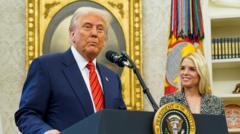In a pivotal moment for Eastern Europe's political landscape, recent presidential elections in Romania and Poland, held on Sunday, marked a significant, albeit cautious triumph for centrist candidates. While many had anticipated a surge in hard-right nationalism, the prevailing outcomes showed that the political center managed to withstand the pressures of growing populism aligned with figures like President Trump.
Eastern Europe's Centrist Resilience Against Nationalist Forces

Eastern Europe's Centrist Resilience Against Nationalist Forces
Recent elections in Romania and Poland reveal a temporary halt to the rise of nationalist politics, as discontent against mainstream parties remains prevalent.
In Romania, independent candidate Nicusor Dan emerged victorious, credited with appealing to voters tired of the corruption linked to traditional parties. Dan, the mayor of Bucharest, captured 54 percent of the vote, overshadowing hardline nationalist George Simion, who had emerged as a formidable contender. The election witnessed an impressive turnout of 64 percent, reflecting a 10 percent increase from the initial round, showcasing Romanian voters' engagement in the democratic process.
The result generated palpable relief among centrist and liberal leaders throughout Europe, including Ursula von der Leyen, President of the European Commission, who commended the Romanian electorate for choosing “the promise of an open, prosperous Romania in a strong Europe.” However, these elections also highlighted a deeper discontent brewing among voters towards established political parties, regardless of their ideologies. As trust in old loyalties wanes, the political future in Eastern Europe remains uncertain, paving the way for potential upheaval amidst a shifting voter landscape.
The result generated palpable relief among centrist and liberal leaders throughout Europe, including Ursula von der Leyen, President of the European Commission, who commended the Romanian electorate for choosing “the promise of an open, prosperous Romania in a strong Europe.” However, these elections also highlighted a deeper discontent brewing among voters towards established political parties, regardless of their ideologies. As trust in old loyalties wanes, the political future in Eastern Europe remains uncertain, paving the way for potential upheaval amidst a shifting voter landscape.





















